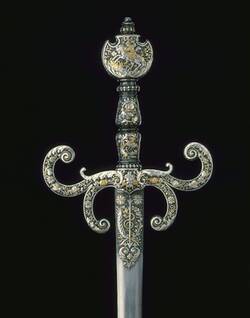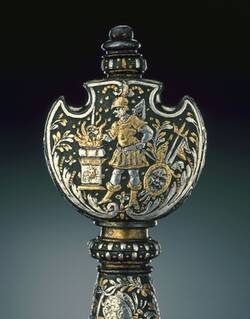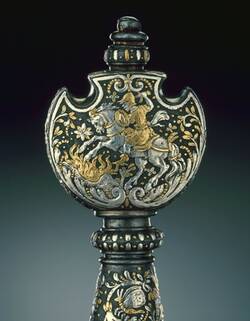The ideas and motifs that we generally associate with Classical Antiquity – the world of Greek and Roman mythology, for instance – would have been familiar to the educated European middle classes until just a few generations ago. To the intellectual elite and the ruling classes of the Renaissance era, however, they were a vital element of their own existence. They were part of a ruler’s identity, and princes and kings decorated their weapons with the heroes and gods of Antiquity as symbols of the virtues and maxims that they themselves aspired to.
Besides images of Christian saints and mottos such as “God is my Hope” and “In Honour Always”, it is the heroes of Classical Rome that most frequently appear on the polished weapons you see here: Marcus Curtius, for instance, – a Roman soldier who, as the historian Livy tells us, suffered an extraordinary fate in 362 B.C. He didn’t die on a battlefield but voluntarily sacrificed his life by leaping into a crevasse that had opened up in the Roman Forum. Legend has it that the crevasse then closed again. And although Livy himself was a little sceptical of the truth of this legend, Marcus Curtius became an enduring symbol of Roman fortitude.
Another popular figure during the Renaissance was the hero Mucius Scaevola. You can see his story portrayed on the hilt of the weapon numbered 4 – a band short sword with fine gold and silver inlays.
Scaevola is said to have saved Rome when the Etruscans besieged the city in 508 B.C. His story is very spectacular, too. Legend has it that in order to demonstrate his resilience to the Etruscan king, Mucius Scaevola thrust his right hand into a fire and did not even flinch as it was burned by the flames.
Although modern medical experts have suggested that he may have suffered from a rare form of insensitivity to pain, this has not tarnished his reputation.
To underpin their claims to the highest office in Saxony, the Electors were keen to be associated not only with martyrs who had suffered for their own people but also with gods and goddesses and allegorical tales – sometimes depicted in spectacular parades, with the Electors themselves playing the roles of classical heroes, gods and rulers.


